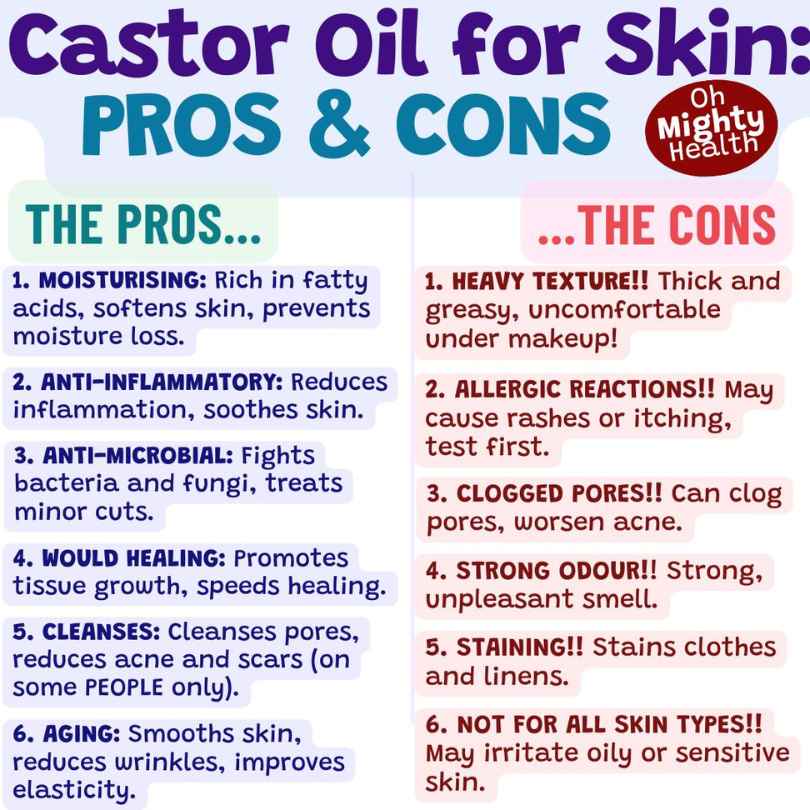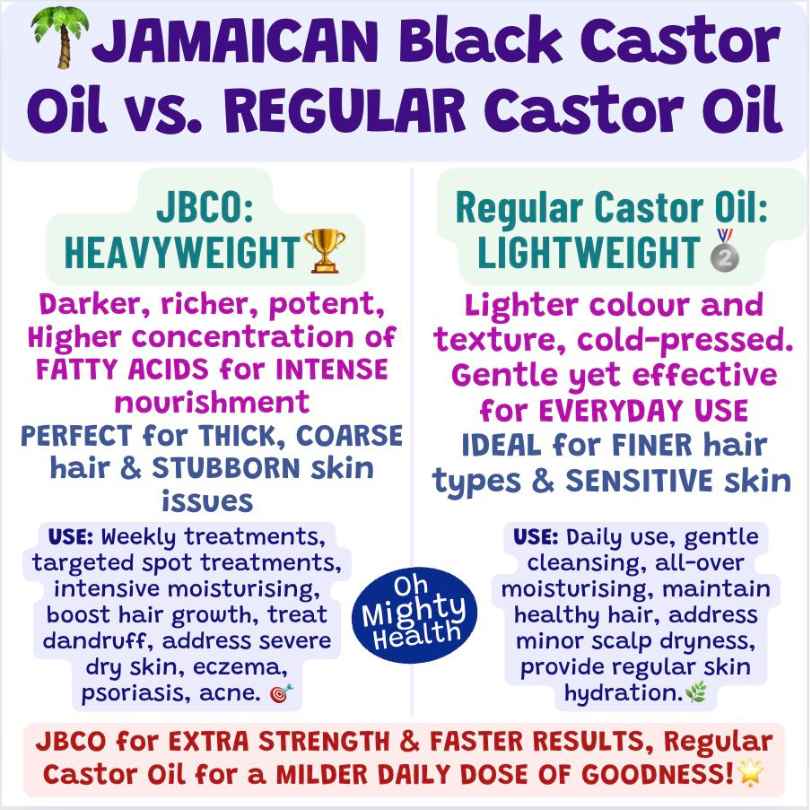The Bad Side of Castor Oil for Skin (Are You Aware?)
Castor oil – not always a miracle worker for your skin!
Castor oil has gained popularity as a natural skincare remedy, praised for its potential to moisturise, soothe, and promote a healthy complexion.
However, before you jump on the castor oil bandwagon, it’s essential to be aware of the potential drawbacks that this seemingly miraculous oil may have on your skin.

Castor oil can cause:
- Allergic reactions
- Acne (yes, it can clog pores)
- Dryness
- Irritation (particularly sensitive skin)
- Greasiness
- Can stain clothes
- Interacts with certain medications (if taking internally)
Also, unrefined castor oil has a strong smell, not for everyone.
I know it is the hype at the moment and everyone seems to rave about it. That’s why YOU HAVE TO READ THE BELOW before jumping into the castor oil band wagon!

1. Allergic reactions: when your skin says “no thanks!” to castor oil
While castor oil is generally considered safe for most people, some individuals may experience allergic reactions upon application. If you notice symptoms such as redness, itching, swelling, or hives after using castor oil on your skin, it’s likely that you have an allergy to the ingredient.
What to do if you experience an allergic reaction
If you suspect an allergic reaction to castor oil, discontinue use immediately and wash the affected area with gentle soap and water. In severe cases, seek medical attention, especially if you experience difficulty breathing or swelling of the face, lips, or tongue.
2. Comedogenic concerns: castor oil’s tendency to clog pores
Castor oil has a relatively high comedogenic rating, meaning it has a higher likelihood of clogging pores compared to other oils. When an oil is comedogenic, it can trap dirt, dead skin cells, and bacteria within the pores, leading to the formation of blackheads, whiteheads, and acne.
Risks for acne-prone skin
If you have acne-prone or oily skin, using castor oil on your face may exacerbate your concerns. The thick, heavy nature of castor oil can create a barrier on the skin’s surface, preventing it from breathing and leading to the development of new breakouts.
3. Dryness and irritation: when castor oil strips your skin of its natural oils
Despite its reputation as a moisturising agent, castor oil can actually cause dryness and irritation for some individuals. This is because castor oil has astringent properties, which can strip the skin of its natural oils when used in excess or too frequently.
Signs of skin irritation
If your skin feels tight, dry, or itchy after using castor oil, it may be a sign that the oil is causing irritation. Other symptoms of skin irritation include redness, flaking, and a burning or stinging sensation.
Importance of patch testing
To minimise the risk of dryness and irritation, it’s crucial to perform a patch test before incorporating castor oil into your skincare routine. Apply a small amount of the oil to a discrete area of skin, such as the inside of your elbow, and wait 24-48 hours to observe any adverse reactions.
4. Heavy texture: thick and greasy, uncomfortable under makeup
Castor oil has a thick, viscous consistency that can feel heavy and greasy on the skin. This texture may be uncomfortable for some individuals, particularly those who prefer lightweight, fast-absorbing skincare products.
Challenges with makeup application
Due to its heavy texture, applying makeup over castor oil can be challenging. The oil may cause your foundation or concealer to slip, crease, or appear uneven, compromising the overall look of your makeup.
5. Odour: strong, unpleasant smell
Castor oil has a distinct, nutty scent that some people find unpleasant. The strong odor may linger on the skin, which can be off-putting for those who are sensitive to smells or prefer their skincare products to have a more subtle fragrance.
Staining: stains clothes and linens
Castor oil’s thick, oily nature can lead to staining of clothes, towels, and bedding. The oil may leave behind greasy marks or discolouration, which can be difficult to remove, especially from light-coloured fabrics.
Tips to minimise staining
To reduce the risk of staining, apply castor oil sparingly and allow it to fully absorb into the skin before coming into contact with fabrics. Consider using old towels or wearing clothing you don’t mind potentially staining when using castor oil on your skin.
6. Not for all skin types: may irritate oily or sensitive skin
While castor oil is often touted as a natural remedy for various skin concerns, it may not be suitable for all skin types. People with oily or sensitive skin may find that castor oil exacerbates their issues, leading to irritation, redness, or breakouts.
Alternatives for oily or sensitive skin
If you have oily or sensitive skin and wish to use a natural oil in your skincare routine, consider lighter options such as jojoba oil, argan oil, or rosehip seed oil. These oils are typically less comedogenic and have a lower likelihood of causing irritation compared to castor oil.
Interactions with medications: castor oil’s potential to cause unwanted side effects
Castor oil may interact with certain medications, leading to undesirable side effects or reduced efficacy of the drugs. This is particularly important to keep in mind if you are using castor oil for its laxative properties or applying it to large areas of the skin.
Examples of medications that may interact with castor oil
Some examples of medications that may interact with castor oil include:
- Diuretics
- Antibiotics
- Blood thinners
- Heart medications
Importance of consulting with a healthcare professional
If you are taking any prescription medications, it’s essential to consult with your healthcare professional before using castor oil, either topically or internally. They can advise you on potential interactions and help you make an informed decision about whether castor oil is safe for you to use.
Quality concerns: the risks of using low-grade castor oil on your skin
Not all castor oil products are created equal. Low-quality or improperly processed castor oil may contain impurities, additives, or contaminants that can harm your skin, leading to irritation, allergic reactions, or other adverse effects.
Differences between high-quality and low-quality castor oil
High-quality castor oil is typically cold-pressed, organic, and hexane-free. It should be pale yellow in color and have a mild, nutty odor. In contrast, low-quality castor oil may be processed using chemical solvents, resulting in a darker color and a strong, unpleasant smell.
Potential contaminants and their effects on the skin
Some potential contaminants found in low-quality castor oil include:
- Ricin: a highly toxic protein that can cause skin irritation and allergic reactions
- Hexane: a chemical solvent that can cause skin dryness and irritation
- Pesticides and herbicides: harmful chemicals that can lead to skin sensitization and other health concerns
Tips for choosing a high-quality castor oil product
When selecting a castor oil product for your skin, look for:
- Cold-pressed, organic, and hexane-free labels
- Pale yellow color and mild, nutty odor
- Reputable brands with transparent sourcing and processing methods
- Glass packaging to prevent leaching of chemicals from plastic containers
Conclusion: be aware of the pros and cons of castor oil for your skin!
While castor oil has gained popularity for its potential skincare benefits, it’s crucial to be aware of the possible drawbacks before incorporating it into your routine. From allergic reactions and comedogenic concerns to interactions with medications and quality issues, castor oil may not be the miracle solution for everyone.
Recap of castor oil’s potential drawbacks
- Allergic reactions
- Pore-clogging properties
- Dryness and irritation
- Interactions with medications
- Quality concerns
Importance of individual skin differences and patch testing
Remember that everyone’s skin is unique, and what works for one person may not work for another. Always perform a patch test before using castor oil on your skin, and pay attention to how your skin reacts to determine if it’s the right choice for you.
Final thoughts on using castor oil safely and effectively
If you decide to use castor oil for your skin, be sure to choose a high-quality product, start with a small amount, and monitor your skin’s response carefully. By being informed and cautious, you can navigate the potential drawbacks of castor oil and make the best decision for your skin’s health and appearance.
Also, the below might interest you!


